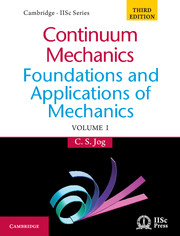Preface
Published online by Cambridge University Press: 05 August 2015
Summary
Apart from the usual goal of presenting a unified treatment of seemingly diverse branches such as solid or fluid mechanics, it is also our goal in this book to discuss some important topics, which have come into prominence in the latter half of the twentieth century, such as material symmetry, frame indifference and thermomechanics. The use of these principles in tandem (of course, in addition to the usual axioms) in many cases delivers the most powerful and beautiful results.
Chapter 1 presents the necessary mathematical background for the following chapters in the form of a brief introduction to tensor analysis. Almost throughout this chapter, the assumed three-dimensional nature of the vector space is exploited to yield shorter proofs of results which in most (but not all) cases also hold for dimensions other than three. In keeping with modern practice, we emphasize the use of direct as opposed to indicial notation, although in many cases we present the proofs using indicial notation also. Presenting the equations in direct notation reinforces the idea that the governing equations are valid with respect to any set of coordinate axes in a given reference frame. It is beneficial, however, to be adept at the use of both, direct and indicial notation. When presenting equations in indicial form, we use only Cartesian components of tensors since we feel that they are sufficient to present the basic principles of the subject. Although other types of components are useful, especially when dealing with curvilinear coordinate systems, we believe that a detailed discussion of say covariant and contravariant components of tensors right at the outset can digress from the purpose of presenting the main physical concepts, and hence, we present them in an Appendix.
Chapter 2 discusses the branch of continuum mechanics known as kinematics, which deals with purely geometrical notions such as strain, rate of deformation, etc.
- Type
- Chapter
- Information
- Continuum MechanicsFoundations and Applications of Mechanics, pp. xvii - xxPublisher: Cambridge University PressPrint publication year: 2015

